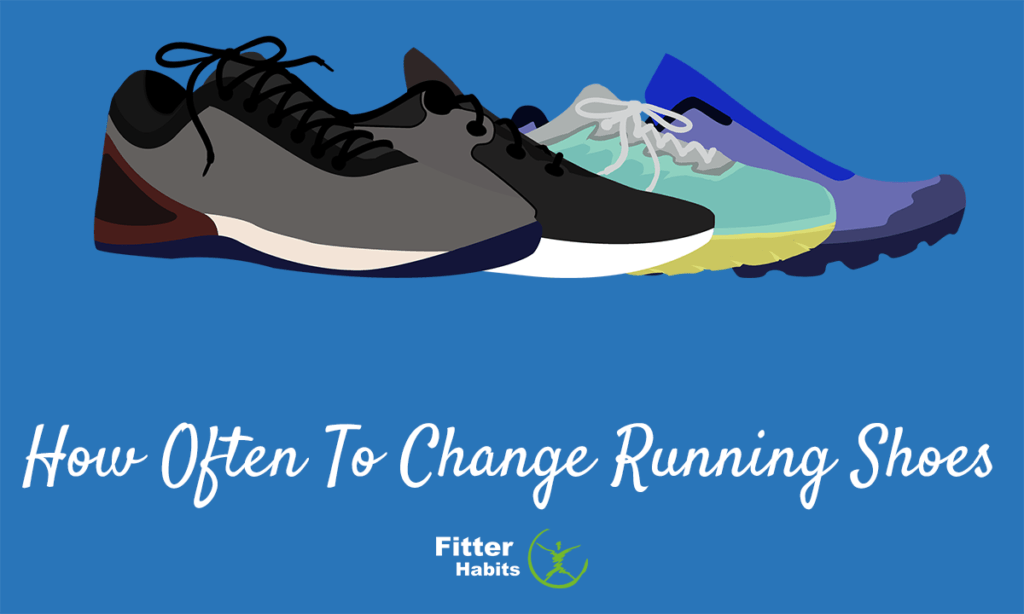Here, we’ll discuss why it’s important to know how often to change running shoes and some easy ways to remind yourself when it’s time to trade up.
Contents
Why Replacing Your Running Shoes Matters

When you look at a worn pair of running shoes, you’ll likely see most of the wear on the outsole of the shoe — the part of your running shoe that meets the road when you run. While this visible wear and tear can affect cushioning and shock absorption, the part of the shoe that has the most effect on your running is the midsole.
The midsole of your shoe is responsible for stopping mid-foot pronation. Some shoes also have a block of foam under the arch of the foot. Wear and tear of the midsole of a running shoe isn’t as visible as outsole issues, however, midsole problems are more likely to cause footstrike problems, leg fatigue, soreness, and leave you more prone to running injuries (like shin splints).
You may also be interested on our 2-in-1 running shorts guide.
Signs That It’s Time To Replace Your Running Shoes

Replacing your running shoes on time can help reduce your risk of injury. Common overuse injuries like plantar fasciitis, shin splints, and even excess muscle soreness can be caused or exacerbated by old shoes.
Experts recommend that you keep an eye out for signs of wear, and replace your running shoes by the 500-mile mark (or as early as the 300-mile mark if your running style tends to make shoes wear out fast). Heel strikers, runners who spend most of their time running on pavement (as opposed to trails or other soft surfaces), and runners with a higher body weight may find that their running shoes last closer to the 300-mile mark, rather than the 500-mile gold standard.
While 500 miles is a good general guideline for replacing your running shoes, there are other factors that you’ll want to consider as well.
Signs that it’s time to replace your running shoes include:
- Unusual, persistent feelings of soreness or tiredness following a run, even though you haven’t changed your speed or upped your mileage recently
- Foot and ankle instability while running
- Shin splints and/or plantar fasciitis
- Obvious signs of wear and tear in the outsole, outside edges, or the upper fabric of the shoe
Not sure if it’s time to replace your running shoes? Head to your local running store for help on whether it’s time to replace your shoes, as well as information on the right shoes for your needs. Running store employees will also be able to work with you if your running form is causing your shoes to wear out quickly.
How To Remember When It’s Time For A New Pair Of Running Shoes
When you find a pair of Asics, Nikes, Brooks, or other new running shoes that you love, it’s easy to forget that they’ll need to be replaced. It’s important that you track your mileage so that you get the most out of the life of your shoes.
Using a running app on your phone can be a great way to keep track of your mileage. Many apps even let you log when you purchase a new pair of running shoes and let you know when you’ve hit your mileage limit and it’s time to shop for a replacement.
If your road running workouts are consistent — you’re a runner who logs 100 miles a month, no matter what — it may make sense for you to simply mark a date on the calendar when it will be time to head to the store for new running shoes.
No matter what method you choose, be sure to have a way to remind yourself to replace your running shoes regularly. Some runners wait until their shoes get uncomfortable to shop for a replacement, but this leaves you vulnerable to overuse injuries.
The Final World On How Often To Change Running Shoes
It’s a good rule of thumb to replace your running shoes at the 500-mile mark. If your shoes show signs of wear earlier, or if you’re a runner who tends to go through shoes more quickly than average, you may want to replace your shoes at the 300-mile mark (or sooner).
Be sure to track your mileage so that you know how often your shoes need to be replaced. Failure to replace your shoes regularly can result in shin splints and other overuse injuries.
FAQs On How Often To Change Running Shoes
How often do running shoes need to be replaced?
Every 500 miles is a good rule of thumb, but certain situations may warrant replacing your shoes more frequently.
What are some signs that it’s time to replace running shoes?
If your shoes are showing noticeable signs of wear, you’re experiencing more fatigue than normal after a run, or you’re noticing telltale signs of overuse injuries, it’s time to make a trip to the running store to look for a new pair of shoes.



